#archives and special collections
Text

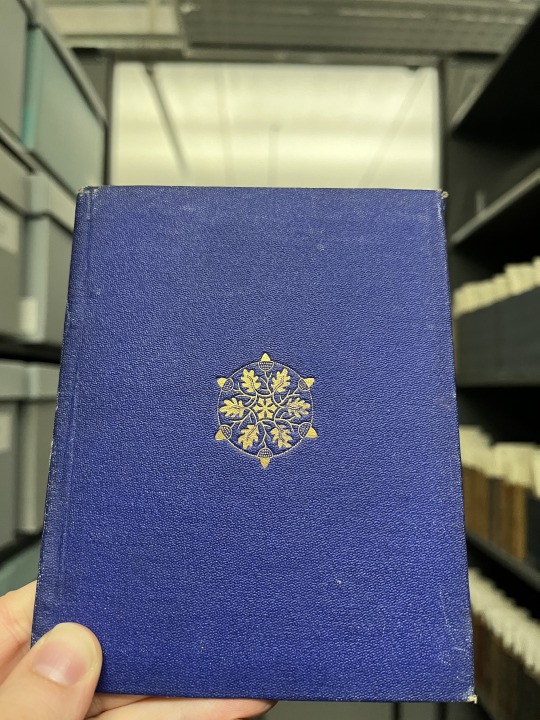
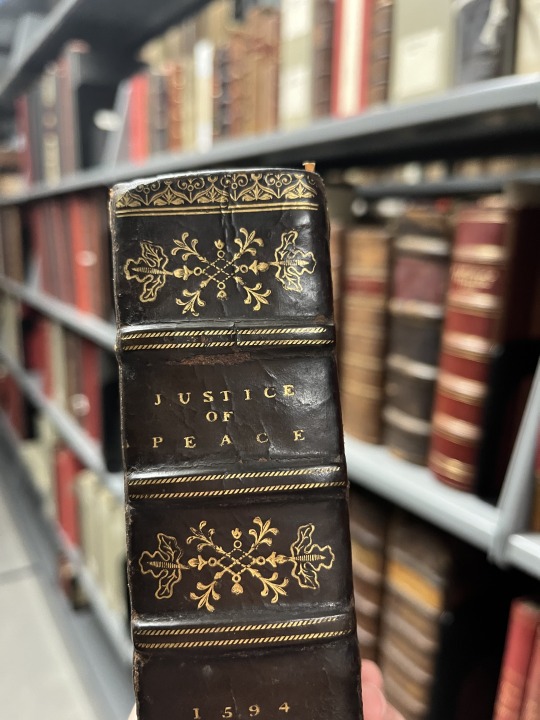
"F" is for fall! The leaves may just be starting to fall here in Minneapolis, but some spines and covers are showing their golden colors on our shelves.
The decorated initial comes from a 1554 book of British Session Laws, and leaves are falling from our copies of American Books with Tails to 'Em (1873) and Eirenarcha, or, Of the Office of the Justices of Peace, in Foure Bookes (1594).
#riesenfeld center#umn#university of minnesota law#university of minnesota law library#rare books#fall#gold#leaves#autumn#special collections#archives and special collections
60 notes
·
View notes
Text
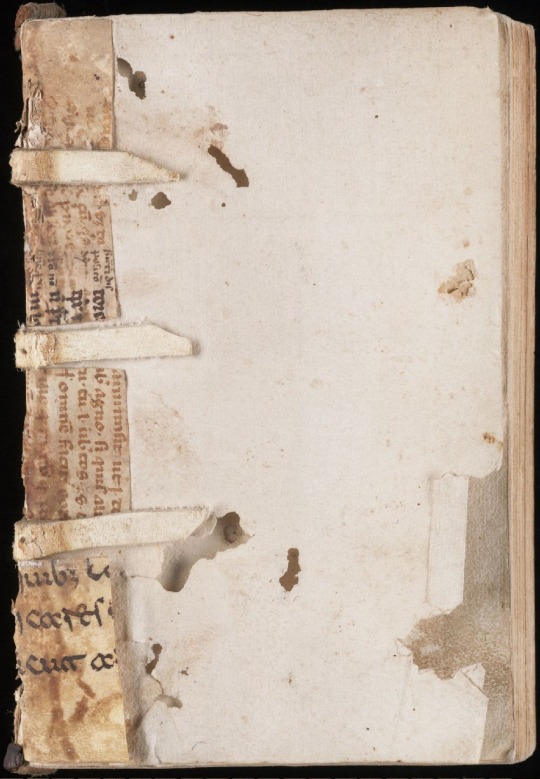
Just some beautiful 16th century binding, with parchment fragments used for reinforcements
📜 @BeineckeLibrary MS 866
#early medieval#medieval manuscript#medievalist#medieval history#medieval manuscripts#medieval#printed books#early modern history#early modern#book history#archives and special collections#special collections
20 notes
·
View notes
Text
Christmas at the Tech, 1912-1963 - Part 3: Christmas Lectures for Young People
To conclude our short series of posts about Christmas activities at Strathclyde’s antecedent institution, the Royal Technical College (RTC, known from 1956 as the Royal College of Science and Technology), we look at the annual Christmas Lectures for Young People. These commenced in the 1950s, upon the suggestion of the Scottish Education Department (SED). Popular science lectures for older children were then an established feature of the Christmas season in London…
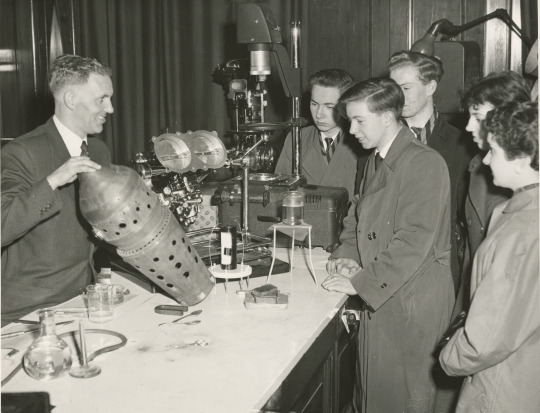
Christmas Lectures for Young People
The RTC’s annual Christmas Lectures for Young People commenced in the early 1950s, upon the suggestion of the Scottish Education Department (SED). Popular science lectures for older children were then an established feature of the Christmas season in London, and the SED, feeling that ‘Scotland was lagging behind England in this matter’, approached the Director of the RTC, Dr (later Sir) David Anderson, in 1951 with the idea of providing similar lectures for secondary school pupils in the West of Scotland.[1] Anderson responded positively, and the first Christmas Lectures for schoolchildren in Glasgow and the West of Scotland, organised by the RTC in conjunction with the SED, were delivered on 3 and 4 January 1952. The presenter, Dr Charles H. Giles of the RTC’s Department of Technical Chemistry, addressed the theme of ‘Chemistry and Colour Photography.’
Having proved successful, the lectures then became a permanent feature in the RTC calendar, taking place every December. Lectures on two different topics, delivered by separate presenters, were offered each year, with both presenters repeating their lecture a second time so that as many children as possible could attend. In session 1953-1954, external academics from the University of Edinburgh and University College, Dublin were invited to come and deliver the lectures. However, it proved so challenging for them to arrange and rehearse their practical demonstrations at the RTC in advance that, in subsequent years, the speakers were selected solely from the staff of the RTC.
The Christmas Lectures for Young People were carried on by the RTC’s successor bodies, the Royal College of Science and Technology (RCST, 1956-1964) and the University of Strathclyde (1964 onwards). While their primary purpose was to inspire and instruct children in aspects of science and technology, the lectures also served to entertain, and the presenters often chose topics that would appeal to children, such as ‘Pests and Parasites’ (1954) and the aptly named ‘Combustion – Some Burning Questions’ (1958). The photograph above shows Dr P.T. Carter, senior lecturer in the Department of Metallurgy, explaining the principles of jet and combustion engines to some of the children who heard him speak on ‘Metals in the Service of Mankind’ in December 1956 (reference: OP4/191).
[1] OE/12/12/24, Papers and correspondence relating to Christmas Lectures. Note on Christmas Lectures, c.1955.
#large#Archives and Special Collections#University of Strathclyde#EYA2022#explorearchives#Christmas#Royal Technical College#Royal College of Science and Technology#Christmas at the Tech
3 notes
·
View notes
Text
You all know that hundreds of libraries around the world are sharing their special collections on JSTOR, right? That they include photos, posters, postcards, buttons, stickers, pamphlets, drawings, and a lot more, right? And that they're all freely accessible to everyone, no login needed, right? Right?
8K notes
·
View notes
Text
The Book of Magical Charms
Ever since we asked for help transcribing and translating the Book of Magical Charms (Newberry MS 5017) in 2017, people have been fascinated with and... concerned about this little manuscript.

But what IS this book, really? It's not a spell book of black magic--it's commonplace book! A collection of recipes, quotations, and yes, magical charms copied down by a lawyer and book collector named Robert Ashley in the 1600s. In a time where the magical and mundane seemed to coexist, Ashley collected a variety of guides that may have been able to help him address health issues--some which claimed to have scientific backing, others which are purely magic. (He also copied down some experiments that were supposed to help him win at dice.)
In early modern England, Christianity and magic were closely linked, and this book would not have been seen as blasphemous. However, it's unlikely that Ashley attempted any of these spells himself, as he had little privacy or ability to procure obscure ingredients. You can see a few excerpts of the book here:
youtube
If you're interested in summoning spirits yourself*, you will be happy to hear that the Book of Charms has been fully transcribed and translated by amazing volunteers. But wait, I hear you saying, I don't see the transcriptions at that link! I only see a very cool manuscript!

Don't worry, it's only a click away. Simply right click then "view details" on any page that you want to see the transcription/translation for, and scroll down to read. The translation follows the transcription in the same text box. Happy summoning!
*The Newberry is NOT liable for anything supernatural that happens if you try to read the Book of Charms out loud.
–Quinn Sluzenski, Digital Initiatives Assistant
View the Book of Charms and more at A Very Newberry Halloween
for more information:
Satterley, Renae. "Robert Ashley and the Authorship of Newberry MS 5017, The Book of Magical Charms." Manuscript Studies: A Journal of the Schoenberg Institute for Manuscript Studies, vol. 6 no. 2, 2021, p. 268-299. Project MUSE, https://doi.org/10.1353/mns.2021.0017.
#libraries#newberry library#special collections#digital humanities#halloween#archives#book of magical charms#magic#spells#newberryq#Youtube#collection stories
330 notes
·
View notes
Text

More love for Trans Awareness Week
"Trans Rights are Human Rights"
Labadie Collection Pinback Buttons LBC.1588
#libraries#archives#special collections#special collections libraries#libraries and archives#labadie collection#trans#transgender#transgender awareness month#transgender awareness week#trans pride#trans rights#trans positivity#trans joy#trans awareness#trans awareness week
196 notes
·
View notes
Text
We are excited to announce that the Kim Deacon Collection photographs are now digitized and available to the public on provlibdigital.org!
#providence public library#LGBTQIA#queer community#queer history#gay bars#special collections#digital archives#digital libraries
95 notes
·
View notes
Text
Today’s passive aggressive United States Senate Memo from the archives…

“A carbon copy from Dr. Chenoweth - be sure you spell his name correctly, or Paul will "bust" you in the head.”
#original content#preservation#archiving#archives#senate#memo#passive aggressive#notes#found in the archives#library#libraries#special collections#misspelling
48 notes
·
View notes
Text
shoutout to lydia nicholas for always playing the best characters ever
#this applies to actual play characters and scripted roles#like sasha rackett? cel sidebottom? mini smithson? melanie king?#they're all amazing#and also their characters from rqg specials!#that barbarian from thanes of beowulf who collected bones? amazing. 10/10. no notes#her storyjam character who was basically controllled by a gun? SUCH a good concept#lydia just manages to play every character in a really compelling and interesting way#rqg#rusty quill gaming#cel sidebottom#sasha rackett#tma#the magnus archives#melanie king#chapter and multiverse#mini smithson#lydia nicholas
49 notes
·
View notes
Photo
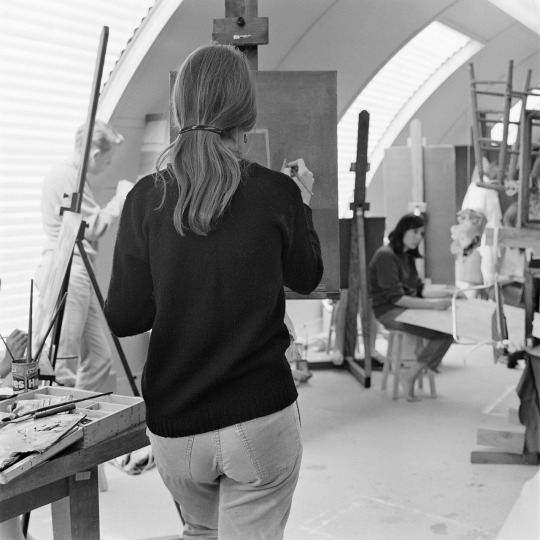
Harry Crosby, UCSD, Visual Arts classroom, 1966
#academia#60s#60s fashion#1960s#1960s fashion#vintage fashion#vintage#artist#visual arts#harry crosby#ucsd#university of california#uc san diego#san diego#easel#artist studio#artist easel#black and white#photography#special collections & archives uc san diego#an3_m333_785_10
150 notes
·
View notes
Text

Hans Waanders, Voice = Geluid = Voix = Stimme, (artist's book with rubber stamps), Compiled, printed and published by, 1995, Edition of 25 signed and numbered copies [The New School Archives and Special Collections, New York, NY. Chelsea Artists' Books Collection, University of the Arts London, London. © The estate of Hans Waanders]


#graphic design#art#drawing#illustration#book#cover#book cover#hans waanders#the new school archives and special collections#chelsea artists' books collection#1990s
48 notes
·
View notes
Text


"Hopefully, he waited for the book to become agitated, but nothing stirred it."
Maybe Claude Noble should have tried to call on Clarence Darrow's spirit a bit closer to Halloween (or waited more than 30 seconds for a breeze).
I stumbled upon this photo, taken in 1940, in our Clarence Darrow collection and had to do a bit of digging. Turns out books are hard to agitate, and Noble tried many times to call on the famous lawyer on the anniversary of his death (this article was published five years after the above photo was taken).
#riesenfeld center#umn#university of minnesota law#university of minnesota law library#special collections#archives and special collections#archives#umn law#clarence darrow#halloween#spirits#magic#magician#psychic mediums#ghosts#law#lawyer
28 notes
·
View notes
Text

A stupendous historiated initial in this Dutch Book of Hours
📜 Walters Art Mus. Walters MS.188. F.117v
#medieval manuscripts#medievalist#medieval history#medieval#archives and special collections#special collections#dark academia
2 notes
·
View notes
Text
Christmas at the Tech, 1912-1963 - Part 1: Students’ Christmas Ball and Children’s Christmas Party
With Christmas time approaching and most of Strathclyde’s students and staff back on campus following the pandemic, many in-person celebrations and festive activities are being planned for the first time in several years. This series of three blog posts looks back at some of the Christmas activities associated with Strathclyde’s antecedent institution, the Royal Technical College (RTC), renamed in 1956 as the Royal College of Science and Technology (RCST) and popularly known as ‘the Tech’. We begin by considering two of the most eagerly anticipated events of all: the students’ Christmas Ball and the Children’s Christmas Party.
Christmas Ball
Organised annually by the Students’ Representative Council (SRC), the Christmas Ball was a major event in the RTC and RCST social calendar and provided a welcome opportunity for students to let their hair down following the end of term exams. To encourage ticket sales, the SRC’s Dance Committee publicised the Ball in the student magazine, The Mask, and in the student newspaper, the Telegraph. The advertisement below was placed in the December 1938 issue of The Mask (reference: OJD/1/2/76).

The Dance Committee (later the Entertainments Committee) invested considerable time and effort to ensure the Ball’s success. In the early years, a hotel in central Glasgow would be booked to host the event: in 1926, for example, the Christmas Dance took place at the Grand Hotel, and in 1930 and 1931 the venue was the Ca’ D’Oro Ballroom. By the 1940s, however, the Christmas Ball generally took place in the RTC’s own Assembly Hall, which doubled as the Exam Hall. The new Student Union building in John Street, which was opened in 1959, later provided appropriate facilities for hosting the Ball and similar functions.
When the Ball was held on campus, the Committee had the unenviable task of decorating the hall for the occasion. In 1944, the RTC’s Navigation Department loaned them some flags for this purpose, ‘and it was [also] decided that the members of the Dance committee should look around the local shops for streamers etc’.[1] In subsequent decades, as the numbers of students studying at the RTC expanded, more resources were available and the new Union building offered increased space and scope for decorations, the Committee’s plans became more ambitious. The early 1960s saw the Christmas Ball organised according to a different theme each year, ranging from ‘Arctic Aurora’ (1960) and ‘Tropical Bally-Ho!’ (1961) to ‘Neptune’s Nocturnals’ (1962: programme pictured below, reference OJA/18/2/3) and ‘Black Friday’ (1963).
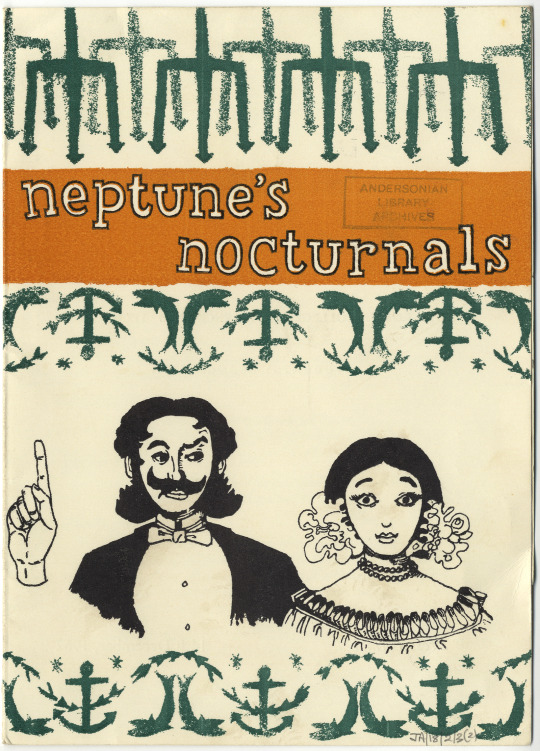
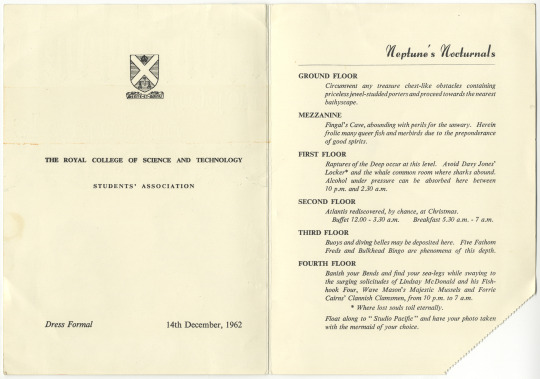
Designing and constructing props and decorations for a themed event demanded specific skills for which the Committee turned to members of the Architecture and Building Society, the RCST’s club for architecture students.[2] As the Committee minutes show, the ‘Architects’ club’ chose the theme for the Ball from a shortlist of suggestions supplied to them by the Committee, opting for that which offered the best artistic and practical possibilities.[3] As well as designing and building the set and props, the architecture students also designed the Ball tickets. Unfortunately, we have no photographs of the themed sets and decorations, but they were impressive, at least according to the writer of this letter in the student newspaper of 13 January 1961:
Dear Madam,
I feel I must write an
appreciation of the decorations for
the Christmas Ball. The Assembly Hall
and the Fourth Floor landing, were
masterpieces in decoration and the
spiral of tinsel down the stair well
was a magnificent welcome on entering
the building. The Architects who de-
-signed the “set” as it were, and also
everyone who helped in any way with
the decorating of the building are to
be congratulated on their wonderful
achievements.
I must, however, deplore
the practice carried out at the Ball
itself, of stripping the Christmas tree
in the Dining Hall of its tinsel so that
the female participants in the Ball
might be decorated still further. Not
only is this tinsel costly, but it did
not greatly enhance the coiffures of the
ladies who were seen wearing it.
To conclude, thanks to the
architects, for the splendid decorations
and no thanks to those members who
spoiled it slightly by ruining the Tree.[4]
The Committee’s labours did not end with decorating the hall, for one of their most important tasks was to engage a suitable band or bands for the evening. The 1950s and 1960s saw combinations of dance bands and jazz bands booked to play at the Ball; by the early 1960s, an additional ‘beat band’ was also booked to play during the interval. The Committee was further responsible for hiring caterers to provide a buffet; arranging the provision of at least one liquor bar; and organising screenings of several short films (mostly cartoons) in rooms adjacent to the main dance hall. If funds permitted, the evening’s entertainment would extend to a cabaret: a ‘Malayan fire eater’, who also performed hypnotism, was booked as the cabaret artist for the Christmas Ball in 1961.[5] Less spectacular (and less dangerous) amusements were also laid on for that year’s event, including ‘Enticing Bingo Sessions’.[6]
As the decades progressed, so too did the hour at which the Ball concluded. In the 1930s, the event tended to finish at 2.00am. In 1944, the students sought permission for the Ball to last all night, but the RTC’s Director, Sir Arthur Huddleston, was averse to the idea.[7] By the late 1950s, however, the Ball was generally scheduled to conclude at 6.00am and ‘breakfast tickets’ were available, entitling each holder to enjoy a hot meal in the early morning before making their way home.[8] In 1960, a double ticket for the Ball cost 25/ and a breakfast ticket cost 3/6d.
Annual Children’s Christmas Party
As well as a Christmas Ball for the students, the Students’ Representative Council of the RTC and RCST organised an annual Christmas party for younger children from local children’s homes, held in the Students’ Union. Transport and catering costs for this event were met from the proceeds of Wednesday lunchtime showings of Fred Quimby’s Tom and Jerry cartoons, organised by the Entertainments Committee. Each student attending the ‘Freds’, as these cartoon screenings were known, was asked to give a donation of 3d.[9]
According to this report in the student newspaper of 13 January 1961, the children’s party was a loud, frenetic, but happy occasion:
The Children’s party was held in
the Union on Wednesday the 28th
December. Children from homes and
orphanages in Glasgow as well as the
children of Union employees were given
a first class treat. [To] The music played
by the members of the College Music
Society, the children enjoyed all their
favourite singing games i.e. “The
Farmer Wants a Wife”, “The Grand Old
Duke of York”, and “Pass the Parcel”.
The band survived although surrounded
by hosts of inquisitive children who
found the microphone a very intriguing
gadget. Lemonade, cakes, jelly, fruit
and ice cream disappeared at an alarming
rate. The children had a break from
balloon bursting and musical
games in an excellent little film show.
Then Santa, alias Ian McClure, gave
them each a present before they went
home.[10]
A more candid report of the same event appears in another section of the newspaper, revealing that, due to an outbreak of mumps among the younger children at one of the homes, a group of 14-year-olds had been dispatched to attend the party in place of the usual 3-8-year-olds. Unsurprisingly, ‘They did not appreciate the Farmer wants a Wife as much as usual and Santa felt perhaps just the tiniest bit embarrassed . . . by giving “Bunny Painting Books” to mature youths. Luckily they were wrapped.’[11] Despite this hiccup, the annual party was both a welcome source of diversion and entertainment for the children, and a rewarding, if physically exhausting afternoon for their student hosts.
Today, Strathclyde’s students and staff continue to bring Christmas cheer to disadvantaged children in Glasgow through the University’s annual Christmas Toy Appeal. Since its inception in 2016, the appeal has provided approximately 8,000 gifts of toys, which have been distributed to six schools and nurseries and 14 charities. Staff and students wishing to participate in this year’s appeal may hand in donations of new, unwrapped toys to the University of Strathclyde Library until 12 December. Cash donations may also be made by following this link: https://onlineshop.strath.ac.uk/product-catalogue/student-experience/widening-access/christmas-toy-appeal-2022.
[1] OJA/6/1, Students’ Representative Council Dance Committee minute book, 1941-1946: minute of meeting on 10 November 1944.
[2] OJA/6/3, Students’ Representative Council Entertainments Committee minute book, 1958-1964: minute of meeting on 24 October 1960, p.92.
[3]OJA/6/3, Students’ Representative Council Entertainments Committee minute book, 1958-1964: minute of meeting on 9 November 1962, p.214.
[4] OJD/3/1, Telegraph vol.1, no.12, 13 January 1961, p.4.
[5] OJA/6/3, Students’ Representative Council Entertainments Committee minute book, 1958-1964: minute of meeting on 9 November 1962, pp.214-216.
[6] OJD/3/2, Telegraph vol.2, no.7, 8 Dec 1961, p.1.
[7] OJA/6/1, Students’ Representative Council Dance Committee minute book, 1941-1946: minute of meeting on 10 November 1944.
[8] OJA/6/3, Students’ Representative Council Entertainments Committee minute book, 1958-1964: minute of meeting on 4 November 1958, p.8.
[9] OJD/3/1, Telegraph vol.1, no.12, 13 January 1961, p.5; OJA/6/3, Students’ Representative Council Entertainments Committee minute book, 1958-1964: minute of meeting on 4 November 1959, p.44.
[10] OJD/3/1, Telegraph vol.1, no.12, 13 January 1961, pp.3-4.
[11] OJD/3/1, Telegraph vol.1, no.12, 13 January 1961, p.5.
#large#Archives and Special Collections#University of Strathclyde#EYA2022#explorearchives#explore your archive#Christmas#20th century#Royal Technical College#Royal College of Science and Technology#Christmas at the Tech
3 notes
·
View notes
Text
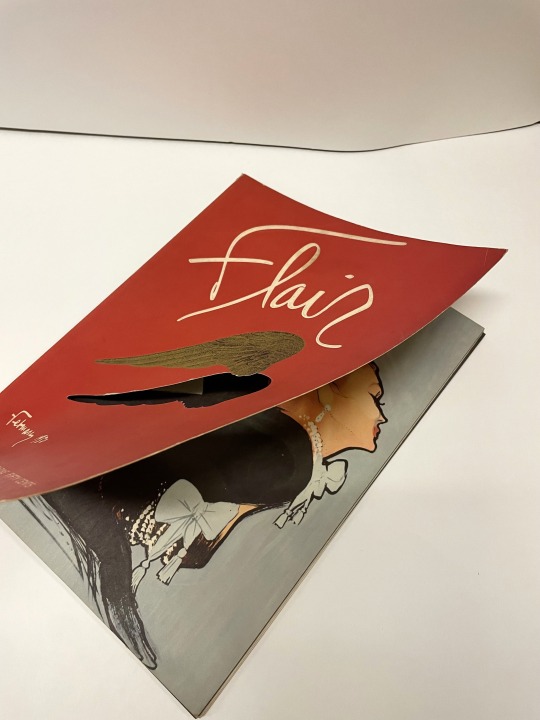
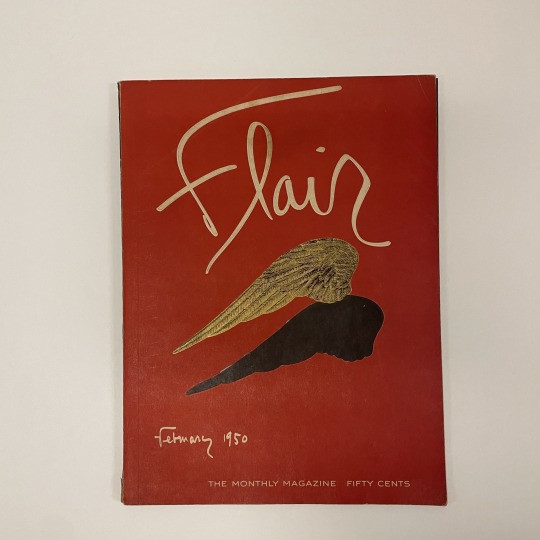
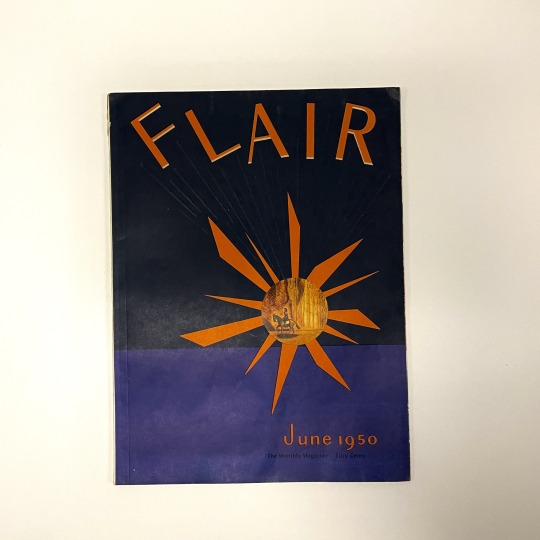
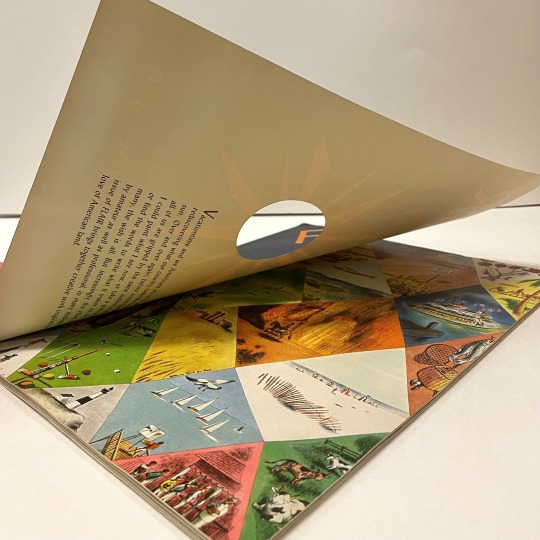



Enjoy the bright colors in this lovely run of Flair, the influential literary, design, and culture magazine launched by Fleur Cowles in 1950. Cowles brought a fine-art focus to what had been a mass-market format, the magazine, and featured the most influential artists, designers, and writers of the day. Some of the photographs here show off the cutouts in the magazine covers, which reveal glimpses of a second design. Read more about Flair in the Paris Review.
#history of journalism#magazines#flair#graphic design#mizzou#special collections#libraries#university of missouri#rare books#bookhistory#illustration#archives#husni collection
31 notes
·
View notes
Text
What is Postcard Tag?
The Newberry Library's Postcard Tag asks the public to help make collections of early 20th century postcards more searchable and accessible for everyone. You can either classify the printed information on the postcard or transcribe handwritten messages from the original senders. Hosted on the crowdsourcing platform Zooniverse, every postcard is random, so you never know what you're going to get next.

We built Postcard Tag to be a fun and easy way for anyone to contribute to scholarship, build better accessibility, and learn more about these (absurd, strange, wonderful) postcards. The Newberry holds one of the largest postcard collections in the world, over 50000 of which are freely available online--with your help they can one day all be fully searchable for future generations!
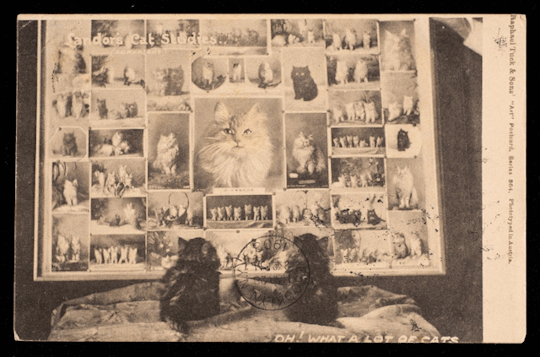
Explore Postcard Tag
Explore all of our digital postcard collections
#newberry library#libraries#special collections#postcards#archives#zooniverse#crowdsourcing#volunteer#digital humanities#vintage#newberryq
101 notes
·
View notes